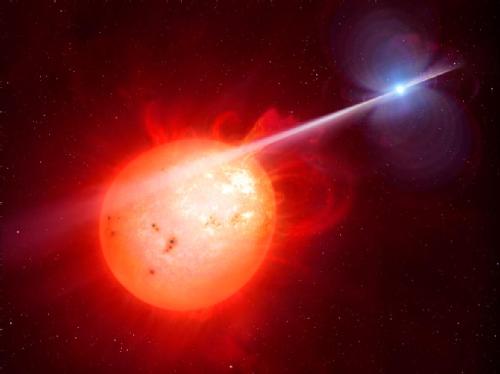The discovery of a rare type of white dwarf provides new insights into the evolution of stars.
White dwarfs are small, dense stars, usually the size of a planet. They form when a low-mass star runs out of fuel and loses its outer layers. They are also called “star fossils” because they allow us to look at the process of star formation and evolution from many angles.
In their study, researchers from the University of Warwick report that they have successfully discovered a second white pulsar. This rare type of white dwarf contains a rapidly spinning, burning white dwarf that bombards its neighbor, a red dwarf, with a powerful barrage of electrically charged particles and radiation, causing the entire system to periodically brighten and then fade. This is due to strong magnetic fields, but researchers are not yet sure what causes this phenomenon.
One of the main theories of strong magnetic fields is the dynamo effect: the cores of white dwarfs act as dynamos (electricity generators) like Earth, but are much more powerful. To verify this theory, the researchers had to search for additional white pulsars.
It was recently published in Nature Astronomy Stady It reports the discovery of a new white pulsar, J191213.72-441045.1 (J1912-4410 for short). This is the second system we know of. The first was the AR Scorpii, which was discovered in 2016.

The white dwarf pulsar, 773 light-years from Earth, rotates 300 times faster than our planet. Its size is similar to that of the Earth, but its mass is at least equal to that of the Sun. In other words, a teaspoon of a white dwarf could weigh about 15 tons. White dwarfs begin their lives as superheated objects, then cool over billions of years. The low temperature of J1912-4410 indicates that it may be very old.
“The source of magnetic fields is an open question in many areas of astronomy, especially in the case of white dwarf stars. The magnetic field of white dwarfs can be up to a million times stronger than that of the sun, and the dynamo effect may help explain why. The discovery of J1912-4410 is a step forward. Mission forward in this field.” said Dr Ingrid Pelisolli (University of Warwick), lead author of the study. “We looked at data from several different surveys of systems with similar characteristics to AR Scorpii. We continued to follow each candidate with the ULTRACAM camera, which can also detect the very rapid brightness changes expected of white dwarf pulsars. After examining dozens of candidates, we found one that had differences in “The brightness is very similar to AR Scorpii. We launched a follow-up campaign with other telescopes, and it turns out that the system is sending radio and X-ray signals in our direction about every five minutes.”
This discovery proved that there are more white dwarf pulsars than previous models had predicted. The discovery of J1912-4410 confirmed other predictions of the dynamo theory. Because of their age, white dwarfs in pulsar systems must be cold. Their companions must be close to it, so white dwarfs’ gravity may have robbed them of mass in the past, which is why they spin so quickly. All of these predictions also apply to the new pulsar: the white dwarf is cooler than 13,000 K, spins on its axis every five minutes, and its gravity strongly influences its companion.”
“This research is an excellent demonstration of how science works – we make predictions and then test them, and this is how science moves forward.”
Axel Schaub (Leibniz Institute for Astrophysics Potsdam), published simultaneously in the Journal of Astronomy and Astrophysics Stady The lead author added: “It is exciting that we found the object during the SRG/eROSITA X-ray sky survey. A follow-up study with the European Space Agency (ESA) XMM-Newton space telescope revealed high-energy pulsations in the X-ray region, confirming the unusual nature of the object.” new and strongly proves that white pulsars are a new type.”
source: University of Warwick
comment






